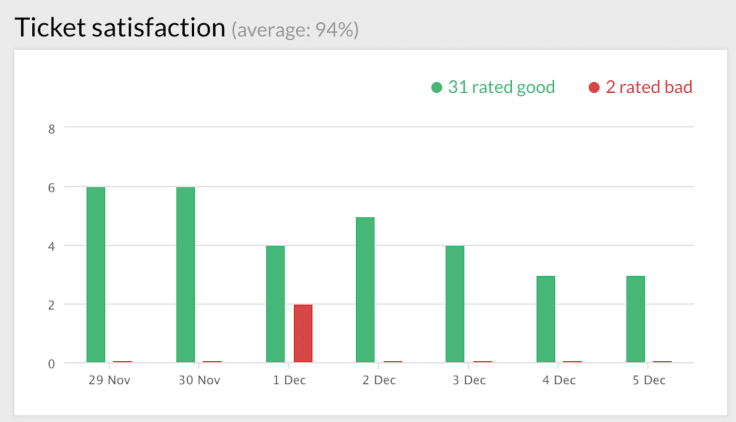Showing top 0 results 0 results found
Showing top 0 results 0 results found


We often get caught up in the nitty-gritty of customer service metrics – how fast we answered a call, our average resolution time, or the ever-popular net promoter score (NPS).
While these metrics are essential, they can sometimes paint an incomplete picture of exceptional customer service's value. It's time to expand our thinking and look beyond individual touchpoints.
If you're already using LiveChat, this post is a must-read (if not, give it a try, it costs nothing). We'll describe the most important live chat metrics, which helped us to turn our customer service into a team of support heroes.
Let's explore how customer service impacts the overall customer journey and ultimately contributes to the success of a business. I hope you’ll find these tips easy to implement too!
The customer journey
The customer journey is seldom straight. It's a complex path filled with multiple interactions across various channels. Customers might browse your website, stumble upon a social media ad, have a question, engage with your chatbot, and finally purchase online or in a physical store.
Each of these touchpoints is a moment to delight or disappoint the customer. Traditional metrics offer insights into isolated slices of the journey, but they fail to provide a comprehensive view of the customer's entire experience.
Why this perspective matters Reframing customer service through the lens of the customer journey and its broader business impact yields transformative benefits. This approach emphasizes the importance of the overall customer experience, ensuring that every support process feels easy and positive, not just focused on closing tickets quickly.
Customer service teams are not just reactionary departments that resolve problems. They are vital stewards of the customer journey, with the power to shape perceptions and influence customer behavior at every stage.
Business impact
Loyal customers are more than just a number. They are the lifeblood of your business and are more likely to return and make repeat purchases. That translates into higher customer lifetime value and a healthier bottom line.
Satisfied customers become brand advocates, spreading positive word-of-mouth to new customers and attracting new business through referrals.
Customer service has a direct impact on customer acquisition costs. It's like having a passionate sales force working for you, but instead of salaries, you're only paying for the price of delivering that exceptional service.
Customer service also plays a hidden role in protecting a company's reputation. A dedicated customer service team, ready to resolve issues proactively, can turn unhappy customers into satisfied ones. Dissatisfied customers left to vent online frustrations can damage a brand's image.
Investing in the journey
Measuring customer satisfaction shouldn't just be a report card exercise. It's about identifying areas along the journey that need improvement and making proactive investments in customer experience.
It requires collaboration across multiple departments — marketing, product development, and customer service. A holistic approach to customer service and the journey it shapes allows organizations to create a competitive advantage that is both sustainable and profitable.
How customer service metrics guide success
Imagine a customer service team as a well-oiled machine – metrics act as the pressure gauges, flow meters, and temperature readings. By analyzing these metrics, businesses can identify areas where the machine runs smoothly and pinpoint potential bottlenecks hindering performance.
Customer service metrics enable businesses to evaluate the quality of service being delivered. Metrics like customer satisfaction scores directly reflect how customers view their interactions with the service team. Did they feel heard and respected, and ultimately, was their issue resolved effectively?
However, metrics go beyond simply measuring satisfaction. They offer insights into efficiency. Average handle time tells a story about the team's ability to address customer inquiries swiftly. At the same time, the first contact resolution rate indicates the effectiveness of resolving issues the first time around. These metrics highlight areas for improvement in processes and training, ensuring that customer service interactions are positive and streamlined.
Customer service metrics can translate customer sentiment into actionable insights. By analyzing these insights, businesses can make informed decisions about resource allocation, training priorities, and product development. For instance, a high volume of inquiries about a specific product feature might trigger a product development team to revisit the design or functionality.
These metrics are not just numbers on a spreadsheet. They are a powerful tool for businesses to assess customer service quality, identify improvement areas, and ultimately ensure a positive customer journey that translates into brand loyalty and business success.
Let's look at some of the most important metrics to further track customer satisfaction in your business,
How customer service metrics guide success
Imagine a customer service team as a well-oiled machine – metrics act as the pressure gauges, flow meters, and temperature readings. By analyzing these metrics, businesses can identify areas where the machine runs smoothly and pinpoint potential bottlenecks hindering performance.
Customer service metrics enable businesses to evaluate the quality of service being delivered. Metrics like customer satisfaction scores directly reflect how customers view their interactions with the service team. Did they feel heard and respected, and ultimately, was their issue resolved effectively?
However, metrics go beyond simply measuring satisfaction. They offer insights into efficiency. Average handle time tells a story about the team's ability to address customer inquiries swiftly. At the same time, the first contact resolution rate indicates the effectiveness of resolving issues the first time around. These metrics highlight areas for improvement in processes and training, ensuring that customer service interactions are positive and streamlined.
Customer service metrics can translate customer sentiment into actionable insights. By analyzing these insights, businesses can make informed decisions about resource allocation, training priorities, and product development. For instance, a high volume of inquiries about a specific product feature might trigger a product development team to revisit the design or functionality.
These metrics are not just numbers on a spreadsheet. They are a powerful tool for businesses to assess customer service quality, identify improvement areas, and ultimately ensure a positive customer journey that translates into brand loyalty and business success.
Let's look at some of the most important metrics to further track customer satisfaction in your business,
Customer satisfaction score (CSAT)
Customer satisfaction score (CSAT) is a vital metric that directly measures how satisfied customers are with a particular interaction or their overall experience with your brand.
Typically, businesses gather CSAT through short surveys with a simple rating scale (like 1-5) or questions prompting customers to rate their level of satisfaction.
The beauty of CSAT lies in its simplicity. It offers a straightforward snapshot of customer sentiment. By analyzing CSAT results, businesses can quickly pinpoint those who had a positive experience and those who might require additional support to improve their perceptions of the brand.
Net promoter score
NPS is a robust metric that gauges a customer's willingness to recommend your company to others. It's usually measured with a straightforward question: "How likely are you to recommend us?" with a number rating on a scale of 0 to 10.
Based on their response, customers are categorized as Promoters (enthusiastic advocates), Passives (satisfied but not likely to promote), or Detractors (potentially unhappy and at risk of spreading negative word-of-mouth). NPS is essential because it provides valuable insight into overall customer loyalty and strongly predicts potential business growth or the risk of customer churn.
Customer effort score (CES)
Customer effort score (CES) is a metric that explicitly measures how easily customers can resolve their issues. A typical CES survey asks, "Please let me know the effort you had to put into fulfilling your request?"
CES is important because it directly addresses the growing customer demand for effortless experiences. It shows the pain points in the customer journey, revealing areas where processes might be overly cumbersome or convoluted. By streamlining these processes, businesses can reduce customer frustration, improve satisfaction, and potentially enhance the likelihood of repeat business.
First contact resolution rate (FCR)
The first contact resolution rate (FCR) is a crucial metric that calculates the percentage of customer inquiries fully resolved during the first interaction without any follow-up communication or escalation to other teams.
A high FCR rate is desirable because it indicates efficiency within your customer support team. It also highlights a smoother customer experience by eliminating the frustration of repeated contacts on the same issue, ultimately contributing to overall customer satisfaction.
Average resolution time (ART)
Average resolution time (ART) measures the average time it takes to resolve a customer problem from the initial point of contact until the ticket is closed. ART offers valuable insight into the speed and efficiency of your customer service team.
How customer service metrics guide success
Imagine a customer service team as a well-oiled machine – metrics act as the pressure gauges, flow meters, and temperature readings. By analyzing these metrics, businesses can identify areas where the machine runs smoothly and pinpoint potential bottlenecks hindering performance.
Customer service metrics enable businesses to evaluate the quality of service being delivered. Metrics like customer satisfaction scores directly reflect how customers view their interactions with the service team. Did they feel heard and respected, and ultimately, was their issue resolved effectively?
However, metrics go beyond simply measuring satisfaction. They offer insights into efficiency. Average handle time tells a story about the team's ability to address customer inquiries swiftly. At the same time, the first contact resolution rate indicates the effectiveness of resolving issues the first time around. These metrics highlight areas for improvement in processes and training, ensuring that customer service interactions are positive and streamlined.
Customer service metrics can translate customer sentiment into actionable insights. By analyzing these insights, businesses can make informed decisions about resource allocation, training priorities, and product development. For instance, a high volume of inquiries about a specific product feature might trigger a product development team to revisit the design or functionality.
These metrics are not just numbers on a spreadsheet. They are a powerful tool for businesses to assess customer service quality, identify improvement areas, and ultimately ensure a positive customer journey that translates into brand loyalty and business success.
Let's look at some of the most important metrics to further track customer satisfaction in your business,
Customer satisfaction score (CSAT)
Customer satisfaction score (CSAT) is a vital metric that directly measures how satisfied customers are with a particular interaction or their overall experience with your brand.
Typically, businesses gather CSAT through short surveys with a simple rating scale (like 1-5) or questions prompting customers to rate their level of satisfaction.
The beauty of CSAT lies in its simplicity. It offers a straightforward snapshot of customer sentiment. By analyzing CSAT results, businesses can quickly pinpoint those who had a positive experience and those who might require additional support to improve their perceptions of the brand.
Net promoter score
NPS is a robust metric that gauges a customer's willingness to recommend your company to others. It's usually measured with a straightforward question: "How likely are you to recommend us?" with a number rating on a scale of 0 to 10.
Based on their response, customers are categorized as Promoters (enthusiastic advocates), Passives (satisfied but not likely to promote), or Detractors (potentially unhappy and at risk of spreading negative word-of-mouth). NPS is essential because it provides valuable insight into overall customer loyalty and strongly predicts potential business growth or the risk of customer churn.
Customer effort score (CES)
Customer effort score (CES) is a metric that explicitly measures how easily customers can resolve their issues. A typical CES survey asks, "Please let me know the effort you had to put into fulfilling your request?"
CES is important because it directly addresses the growing customer demand for effortless experiences. It shows the pain points in the customer journey, revealing areas where processes might be overly cumbersome or convoluted. By streamlining these processes, businesses can reduce customer frustration, improve satisfaction, and potentially enhance the likelihood of repeat business.
First contact resolution rate (FCR)
The first contact resolution rate (FCR) is a crucial metric that calculates the percentage of customer inquiries fully resolved during the first interaction without any follow-up communication or escalation to other teams.
A high FCR rate is desirable because it indicates efficiency within your customer support team. It also highlights a smoother customer experience by eliminating the frustration of repeated contacts on the same issue, ultimately contributing to overall customer satisfaction.
Average resolution time (ART)
Average resolution time (ART) measures the average time it takes to resolve a customer problem from the initial point of contact until the ticket is closed. ART offers valuable insight into the speed and efficiency of your customer service team.
Tracking ART allows you to identify potential bottlenecks that are slowing down resolution processes. It helps pinpoint areas where additional resources, process improvements, or better training might be necessary to expedite problem-solving and enhance the customer experience.
Average handle time (AHT)
Average handle time (AHT) is a metric that tracks the average duration of a customer interaction from start to finish. It includes talk time, any hold time the customer experiences, and any follow-up work the agent might need to do after the interaction ends.
AHT plays a role in workforce planning and capacity management, helping businesses determine how many agents are required to handle the volume of customer inquiries adequately.
Additionally, by tracking AHT against other metrics like resolution time or customer satisfaction, businesses can pinpoint processes that may be unnecessarily long or complex, like what may be impacting operational efficiency for all customers.

Tracking ART allows you to identify potential bottlenecks that are slowing down resolution processes. It helps pinpoint areas where additional resources, process improvements, or better training might be necessary to expedite problem-solving and enhance the customer experience.
Average handle time (AHT)
Average handle time (AHT) is a metric that tracks the average duration of a customer interaction from start to finish. It includes talk time, any hold time the customer experiences, and any follow-up work the agent might need to do after the interaction ends.
AHT plays a role in workforce planning and capacity management, helping businesses determine how many agents are required to handle the volume of customer inquiries adequately.
Additionally, by tracking AHT against other metrics like resolution time or customer satisfaction, businesses can pinpoint processes that may be unnecessarily long or complex, like what may be impacting operational efficiency for all customers.
Customer churn rate
This metric shows the proportion of customers who terminate their association with your company within a particular time frame.
It's a critical indicator of customer retention and directly impacts your company's financial health.
Analyzing the reasons behind churn provides valuable clues that customer support teams can use to their advantage.
They might uncover patterns related to product shortcomings, poor service experiences, or competitor offerings, allowing them to identify trends and proactively implement adjustments to enhance loyalty and keep customers returning.
How do companies collect data?
Don't focus on any one metric in isolation. The most valuable insights often come from analyzing several metrics together, as they paint a more complete picture of the customer service experience you provide.
You should also consider how you're going to gather the data. In the next section, you'll see how data is typically collected.
Customer feedback surveys
Customer feedback surveys are a versatile tool for collecting meaningful customer service metrics.
They can be sent directly to customers after interactions via email or SMS or strategically embedded within your website or app, allowing you to target specific metrics like CSAT, NPS, and CES.
Surveys can also be triggered automatically after a support ticket is closed, giving you immediate feedback on how the issue was resolved and the customer's overall experience.
Analyzing call center logs
Call recordings offer more than just an audio record of customer interactions; they are a treasure trove of qualitative data.
Analyzing call recordings allows businesses to identify common pain points, training gaps, and potential areas where processes can be improved.
Sophisticated tools can transform speech to text, making call transcripts searchable, a powerful resource for analyzing keywords, sentiment, and overall trends within customer interactions.
Even seemingly basic metadata like call duration, hold times, and the number of transfers within a call can provide significant insights into average handle time and call volume patterns and help businesses make informed decisions about staffing needs.
Monitoring social media mentions
Social listening tools act as your company's ears on the ground in the bustling world of social media.
They constantly monitor platforms for any mentions of your business, products, or relevant keywords, keeping track of sentiment, the volume of mentions, and the specific issues customers raise.
Social media is a two-way street. By responding directly to comments, questions, and complaints on social media, you can resolve issues in a public forum and gather valuable qualitative feedback that can help shape your customer service strategies.
Website and app analytics
Website and app analytics offer a window into the customer's digital journey. Tools like heatmaps and behavior tracking visually reveal how customers interact with your application or website.
They can pinpoint specific areas where customers encounter friction or decide to drop off their journey altogether.
This data lets you zero in on recurring customer problems or persistent pain points within your product or service, giving you the insight you need to make impactful changes.
Text analytics
Text analytics software is a powerful tool that uses natural language processing to understand large volumes of unstructured text data—think support emails, chat transcripts, and social media posts.
This type of software can extract sentiment, helping you understand whether customer interactions are predominantly positive or negative.
It can categorize issues, reveal common customer pain points, and even identify trends buried within those text conversations.
These insights can pinpoint areas of improvement across your products, services, and customer support processes.
Additional methods
Don't overlook the power of customer reviews and the knowledge your frontline team holds. Analyzing reviews on platforms like Google and Trustpilot can reveal common themes within customer feedback, both positive and negative.
Your customer service agents interact directly with customers every day and have a unique understanding of their experiences.
Regular check-ins, feedback sessions, and soliciting input from your agents can provide precious insights that enhance your knowledge of customer needs and potential areas for improvement.
How businesses use customer service metrics to find room for improvement
Customer service metrics are a business diagnostic tool that pinpoints underlying issues or areas with untapped potential.
They offer far more than a numerical scorecard; they provide a roadmap for strategic improvement.
With these insights, impactful strategies can be implemented. Low FCR rates could indicate gaps in agent training or insufficient access to knowledge resources.
Let's examine how businesses leverage these metrics to identify areas for improvement and implement the right solutions. Imagine your NPS has been steadily declining. This metric signals an alarming need for action. Digging deeper, it correlates with a lower customer satisfaction score. Now, you're zeroing in on an area requiring attention. But what exactly is happening? A clearer picture emerges using key performance indicators and coupling those scores with qualitative survey responses and text analysis of customer interactions. Perhaps common complaints highlight long wait times, a lack of first-contact resolution, or inconsistent knowledge among agents. These are your red flags.
In this case, the solution might involve revamping training modules, updating internal knowledge bases, or implementing tools that help agents find information quickly.
Furthermore, analyzing call center logs and transcripts can identify specific process-level problems.
If calls are consistently transferred multiple times, perhaps it highlights a need to revise your call routing system or create more specialized teams with more profound expertise.
Long hold times might signal staffing shortages, prompting strategic scheduling and workforce management adjustments.
What customer metrics show
Customer service metrics also show how customers interact with your digital properties. If heatmaps and behavior tracking on your website reveal a high drop-off rate on your FAQ page, it's a tell-tale sign that it needs improvement.
The content may need to be rewritten, search functionality enhanced, or its design overhauled for better usability.
Social media listening lets you react to individual concerns and aids in pattern recognition. A spike in negative sentiment, particularly surrounding a particular issue, points to a potential product flaw or an emerging problem within your service process that needs to be addressed.
Data is most potent when it's connected to real-world impact. Regularly reviewing customer churn rate against support metrics can reveal whether poor customer service experiences contribute to customer loss. This knowledge then arms you to proactively address root causes and prioritize retention initiatives.
Customer service metrics are not static. Your metrics and strategies must adapt as your business grows and customer expectations shift.
By regularly analyzing data, companies can identify areas for improvement, implement changes, and continually refine their approach to customer service.
The result? Improved numbers on a dashboard, a more loyal customer base, and a business that becomes synonymous with exceptional experiences.
Since you know how companies can use metrics, let's talk about how customer relationship management (CRM) comes into play.
Customer relationship management software
Technology is indispensable in helping businesses effectively track and manage many important customer service metrics. CRM software is the central nervous system for customer interactions.
It is a comprehensive data repository, capturing everything from purchase history and contact information to detailed notes on every support case and feedback survey. Think of it as the meticulously organized filing cabinet of the modern customer service world.
Data analytics tools transform your CRM's vast sea of information into actionable intelligence. These tools can dig through mountains of data, identifying trends, correlations, and anomalies that would otherwise escape human detection. They can also visualize complex data sets, revealing patterns in customer behavior through visually compelling dashboards and reports.
Imagine seeing the average resolution time for customer inquiries or tracking how sentiment scores fluctuate based on product releases or service updates. This level of insight, powered by analytics tools, arms businesses with the knowledge to make data-driven decisions. They might use this data to tailor training programs targeting specific knowledge gaps or to pinpoint bottlenecks in processes so they can be streamlined for better efficiency.
Many CRM systems and analytics platforms offer predictive capabilities. Using historical data and machine learning techniques, these tools can forecast customer churn risks, helping to identify potentially dissatisfied customers.
The seamless integration of CRM software with communication channels like email, phone, and social media ensures customer interactions are logged and meticulously tracked.
This centralized view creates a comprehensive timeline of a customer's journey, enhancing the quality of each interaction as agents always have the full context at their fingertips.
Let’s look at more in-depth details about the main highlights of CRM systems.
Key uses
While technology is a powerful enabler, it's important to remember that it's just one piece of the puzzle. Successful customer service metric tracking and management also require a clear strategy, well-defined goals, and a culture that values continuous improvement.
When used strategically, technology becomes the potent fuel that accelerates progress toward delivering exceptional customer experiences.
Data accessibility
CRM software offers comprehensive reporting tools that help you track critical metrics for customer service operations, such as average resolution, average response time, first-contact resolution rate, and changes in customer satisfaction levels across all your support channels. This lets you gain valuable insights into your customer support operations and make data-driven decisions to improve service quality.
Personalization at scale
CRM systems are designed to store and manage vast amounts of information about customers, including their preferences, past purchases, and support history.
This wealth of data enables customer service agents to provide personalized and efficient interactions, even when dealing with a high volume of inquiries. Leveraging the insights and knowledge gathered by CRMs lets customer support agents offer tailored solutions and recommendations that cater to each customer's unique needs and expectations.
Data analytics tools
Analytics platforms offer advanced data analysis capabilities that go beyond the standard reporting features found in CRM systems. These platforms can provide interactive visualizations of complex data relationships, allowing you to identify correlations and patterns that might otherwise be difficult to detect. With powerful data modeling tools and advanced algorithms, analytics platforms can help you better understand your data and make more informed business decisions.
Identifying patterns
Sophisticated analytics softwares can unravel intricate patterns in customer queries, behavior, support volume, and satisfaction scores. Unlike basic reports, these tools can provide in-depth insights into the data, enabling businesses to make informed decisions and take necessary actions based on these insights.
For customer support requests, for instance, organizations can optimize their staffing levels by analyzing peak support times to ensure maximum efficiency and productivity. This ensures that every customer query is effectively addressed, improving customer experiences and overall satisfaction.
Text analytics and sentiment analysis
Advanced analytics tools leverage the power of artificial intelligence and machine learning algorithms to delve deeper into the content and sentiment of support transcripts and social media posts.
Analyzing tone, language, and other contextual factors, these tools help businesses gain a more comprehensive understanding of their customers' experiences, needs, and pain points. With these insights, companies can make more informed decisions and take more effective actions to enhance customer satisfaction, loyalty, and overall business success.
The cycle of continuous improvement
Customer service metrics are far more than static figures. They hold the key to unlocking the secrets of customer satisfaction and, by extension, the path to lasting business success.
Think of customer service metrics as a compass, guiding your business toward exceptional customer experiences. However, a compass is only helpful if you continually check your bearings and adjust your course.
The journey of exceptional customer service is never truly finished. It's a continuous cycle: You must gather data, analyze insights, implement solutions, and then re-evaluate your metrics to measure progress.
This constant state of analysis and refinement is what separates good customer service from genuinely exceptional experiences that cultivate loyalty and growth.
Remember, customer expectations are constantly evolving. What defines a positive customer experience today could be the baseline tomorrow. Businesses that remain stagnant will be left behind.
Those who continuously monitor their metrics, identifying successes and potential friction points, are positioned to adapt and stay ahead of the curve.
Technology, with CRM systems and analytics tools, plays a vital role. It allows us to manage, measure, and glean insights from the vast customer data. However, don't let the tools overshadow the ultimate goal.
Ready to take the steps needed for your business to thrive?
LiveChat is an excellent software for tracking metrics. Let's review the highlights of this software.
Preset messages
Use the power of proactive chat invitations to transform your website into a sales powerhouse! With preset messages, you can automatically engage potential customers when they land on your site.
Strategically tailor these proactive prompts based on the specific pages they're visiting, the contents of their cart, or even their geolocation. These timely invitations break the ice, guide visitors towards helpful resources, and open the door to conversions from the first interaction, boosting your sales potential from day one.
Integrations
With LiveChat's extensive integrations, you and happy customers can provide seamless customer support across various popular communication channels. Connect WhatsApp Business, Messenger, Apple Messages for Business, and other platforms directly into your LiveChat dashboard.
Customers can reach you on their preferred channel while your agents manage all interactions from a single, centralized interface. That way a consistent and streamlined experience for your customers is ensured, regardless of how they contact you.
Product recommendations
Integrating LiveChat with significant ecommerce platforms can turn your live chat into a sales and conversion engine. This connection lets agents access customer purchase history, view shopping cart contents, and make personalized product recommendations directly within the chat window. Proactively offering relevant suggestions or facilitating quick upsells enhances customers' shopping journeys and increases their overall order value.
Boost efficiency
Use AI and automation to supercharge your live chat support with LiveChat's suite of efficiency-boosting tools:
AI Assist
Respond to customers with lightning speed using AI Assist, which generates instant reply suggestions tailored to the conversation's context. This helps agents handle more inquiries simultaneously while ensuring accuracy.
Chat summary
Get up-to-speed quickly by having AI automatically summarize past chat transcripts. This eliminates the need to read lengthy histories, especially during hand-offs or when revisiting open cases.
Live Assistant
Access the knowledge you need when you need it. Live Assistant pulls instant reply suggestions directly from your knowledge base or other integrated sources, ensuring consistent answers and saving agents valuable search time.
Data and optimization
LiveChat helps you make data-informed decisions without needing a dedicated data analyst. Its intuitive reporting dashboards present key metrics in a clear, visual format that's easy to understand and interpret. Monitor chat volume trends, agent performance, customer satisfaction scores, etc.
Use these insights to optimize staffing, identify training needs, and recognize areas where you can improve the customer support experience. Feel confident making business decisions rooted in concrete data, leading to measurable success.
Ready to start? Try a free trial and see how LiveChat can take your business to the next level.
You might also like 5 Ways You Can Use Live Chat in Conversion Rate Optimization.








Comments